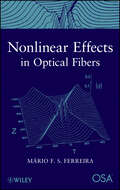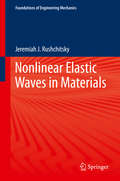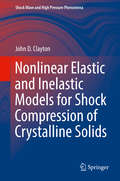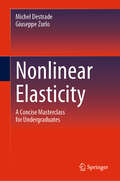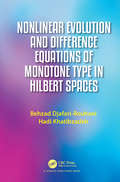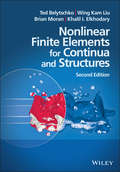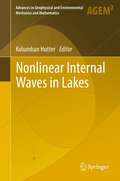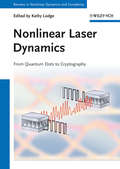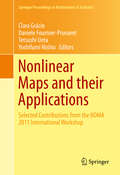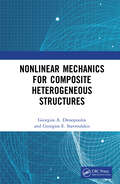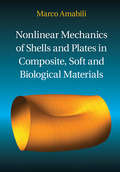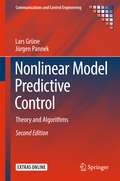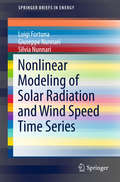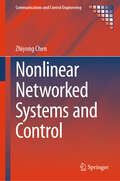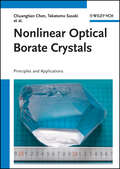- Table View
- List View
Nonlinear Dynamics: Materials, Theory and Experiments
by Mustapha Tlidi Marcel G. ClercThis book presents recent advances, new ideas and novel techniques related to the field of nonlinear dynamics, including localized pattern formation, self-organization and chaos. Various natural systems ranging from nonlinear optics to mechanics, fluids and magnetic are considered. The aim of this book is to gather specialists from these various fields of research to promote cross-fertilization and transfer of knowledge between these active research areas. In particular, nonlinear optics and laser physics constitute an important part in this issue due to the potential applications for all-optical control of light, optical storage, and information processing. Other possible applications include the generation of ultra-short pulses using all-fiber cavities.
Nonlinear Effects in Optical Fibers (Wiley-OSA Series on Optical Communication #2)
by Mario F. FerreiraThis book will provide insight into the principles and applications of nonlinear effects in fibers for students, researchers, and developers who have a basic understanding of electromagnetic theory under their belts. It will explore the physics, limitations, applications, and research results surrounding nonlinear effects in fiber optics. In addition to communications, optical fibers are already used in medical procedures, automobiles, and aircraft and are expected to have many other applications. This will expand the range of industry workers who will find a book of this type useful.
Nonlinear Elastic Waves in Materials
by Jeremiah J. RushchitskyThe main goal of the book is a coherent treatment of the theory of propagation in materials of nonlinearly elastic waves of displacements, which corresponds to one modern line of development of the nonlinear theory of elastic waves. The book is divided on five basic parts: the necessary information on waves and materials; the necessary information on nonlinear theory of elasticity and elastic materials; analysis of one-dimensional nonlinear elastic waves of displacement - longitudinal, vertically and horizontally polarized transverse plane nonlinear elastic waves of displacement; analysis of one-dimensional nonlinear elastic waves of displacement - cylindrical and torsional nonlinear elastic waves of displacement; analysis of two-dimensional nonlinear elastic waves of displacement - Rayleigh and Love nonlinear elastic surface waves. The book is addressed first of all to people working in solid mechanics - from the students at an advanced undergraduate and graduate level to the scientists, professionally interesting in waves. But mechanics is understood in the broad sense, when it includes mechanical and other engineering, material science, applied mathematics and physics and so forth. The genesis of this book can be found in author's years of research and teaching while a head of department at SP Timoshenko Institute of Mechanics (National Academy of Sciences of Ukraine), a member of Center for Micro and Nanomechanics at Engineering School of University of Aberdeen (Scotland) and a professor at Physical-Mathematical Faculty of National Technical University of Ukraine "KPI". The book comprises 11 chapters. Each chapter is complemented by exercises, which can be used for the next development of the theory of nonlinear waves.
Nonlinear Elastic and Inelastic Models for Shock Compression of Crystalline Solids (Shock Wave and High Pressure Phenomena)
by John D. ClaytonThis book describes thermoelastic and inelastic deformation processes in crystalline solids undergoing loading by shock compression. Constitutive models with a basis in geometrically nonlinear continuum mechanics supply these descriptions. Large deformations such as finite strains and rotations, are addressed. The book covers dominant mechanisms of nonlinear thermoelasticity, dislocation plasticity, deformation twinning, fracture, flow, and other structure changes. Rigorous derivations of theoretical results are provided, with approximately 1300 numbered equations and an extensive bibliography of over 500 historical and modern references spanning from the 1920s to the present day. Case studies contain property data, as well as analytical, and numerical solutions to shock compression problems for different materials. Such materials are metals, ceramics, and minerals, single crystalline and polycrystalline.The intended audience of this book is practicing scientists (physicists, engineers, materials scientists, and applied mathematicians) involved in advanced research on shock compression of solid materials.
Nonlinear Elasticity: A Concise Masterclass for Undergraduates
by Michel Destrade Giuseppe ZurloThis textbook provides a rigorous yet accessible introduction to Nonlinear Elasticity aimed at undergraduate students in a compact text. Rooted in concepts from first- and second-year undergraduate Linear Algebra and Calculus (and very little Tensor Algebra), the book touches upon all the fundamental aspects of nonlinear elasticity, from the analysis of deformation and stress, to the constitutive response and modelling of soft solids, to the lab experiments required to obtain their material properties, and to the concepts of equilibrium and energy minimization. Nonlinear Elasticity is an elegant, physics-based, mathematical theory, one usually only available at graduate level to students in advanced studies of engineering, applied mathematics, and theoretical physics. Over the past ten years, the authors developed a classroom-tested pedagogy aimed at narrowing the range of the skills required to approach Nonlinear Elasticity from the perspective of an undergraduate student pursuing a Bachelor of Science or Engineering, as displayed in this book. It concludes with an analysis of several worked examples, spanning a variety of problems of high technical importance and relevance. The book is organized for use as a core text in the classroom or as a self-contained guide of (24 lectures) for independent learning.
Nonlinear Evolution and Difference Equations of Monotone Type in Hilbert Spaces
by Behzad RouhaniThis book is devoted to the study of non-linear evolution and difference equations of first or second order governed by maximal monotone operator. This class of abstract evolution equations contains ordinary differential equations, as well as the unification of some important partial differential equations including heat equation, wave equation, Schrodinger equation, etc. The book contains a collection of the authors' work and applications in this field, as well as those of other authors.
Nonlinear Filtering and Smoothing: An Introduction to Martingales, Stochastic Integrals and Estimation (Dover Books on Electrical Engineering)
by Venkatarama KrishnanMost useful for graduate students in engineering and finance who have a basic knowledge of probability theory, this volume is designed to give a concise understanding of martingales, stochastic integrals, and estimation. It emphasizes applications. Many theorems feature heuristic proofs; others include rigorous proofs to reinforce physical understanding. Numerous end-of-chapter problems enhance the book's practical value.After introducing the basic measure-theoretic concepts of probability and stochastic processes, the text examines martingales, square integrable martingales, and stopping times. Considerations of white noise and white-noise integrals are followed by examinations of stochastic integrals and stochastic differential equations, as well as the associated Ito calculus and its extensions. After defining the Stratonovich integral, the text derives the correction terms needed for computational purposes to convert the Ito stochastic differential equation to the Stratonovich form. Additional chapters contain the derivation of the optimal nonlinear filtering representation, discuss how the Kalman filter stands as a special case of the general nonlinear filtering representation, apply the nonlinear filtering representations to a class of fault-detection problems, and discuss several optimal smoothing representations.
Nonlinear Finite Elements for Continua and Structures
by Khalil Elkhodary Ted Belytschko Brian Moran Wing Kam LiuThis updated and expanded edition of the bestselling textbook provides a comprehensive introduction to the methods and theory of nonlinear finite element analysis. New material provides a concise introduction to some of the cutting-edge methods that have evolved in recent years in the field of nonlinear finite element modeling, and includes the eXtended finite element method (XFEM), multiresolution continuum theory for multiscale microstructures, and dislocation-density-based crystalline plasticity.Nonlinear Finite Elements for Continua and Structures, Second Edition focuses on the formulation and solution of discrete equations for various classes of problems that are of principal interest in applications to solid and structural mechanics. Topics covered include the discretization by finite elements of continua in one dimension and in multi-dimensions; the formulation of constitutive equations for nonlinear materials and large deformations; procedures for the solution of the discrete equations, including considerations of both numerical and multiscale physical instabilities; and the treatment of structural and contact-impact problems.Key features:Presents a detailed and rigorous treatment of nonlinear solid mechanics and how it can be implemented in finite element analysisCovers many of the material laws used in today's software and researchIntroduces advanced topics in nonlinear finite element modelling of continuaIntroduction of multiresolution continuum theory and XFEMAccompanied by a website hosting a solution manual and MATLAB® and FORTRAN codeNonlinear Finite Elements for Continua and Structures, Second Edition is a must have textbook for graduate students in mechanical engineering, civil engineering, applied mathematics, engineering mechanics, and materials science, and is also an excellent source of information for researchers and practitioners in industry.
Nonlinear Functional Analysis with Applications to Combustion Theory (Applied Mathematical Sciences #221)
by Kazuaki TairaExplore the fascinating intersection of mathematics and combustion theory in this comprehensive monograph, inspired by the pioneering work of N. N. Semenov and D. A. Frank-Kamenetskii. Delving into the nonlinear functional analytic approach, this book examines semilinear elliptic boundary value problems governed by the Arrhenius equation and Newton's law of heat exchange. Key topics include: Detailed analysis of boundary conditions, including isothermal (Dirichlet) and adiabatic (Neumann) cases. Critical insights into ignition and extinction phenomena in stable steady temperature profiles, linked to the Frank-Kamenetskii parameter. Sufficient conditions for multiple positive solutions, revealing the S-shaped bifurcation curves of these problems. Designed for researchers and advanced students, this monograph provides a deep understanding of nonlinear functional analysis and elliptic boundary value problems through their application to combustion and chemical reactor models. Featuring detailed illustrations, clearly labeled figures, and tables, this book ensures clarity and enhances comprehension of complex concepts. Whether you are exploring combustion theory, functional analysis, or applied mathematics, this text offers profound insights and a thorough mathematical foundation.
Nonlinear Hamiltonian Mechanics Applied to Molecular Dynamics
by Stavros C. FarantosThis brief presents numerical methods for describing and calculating invariant phase space structures, as well as solving the classical and quantum equations of motion for polyatomic molecules. Examples covered include simple model systems to realistic cases of molecules spectroscopically studied. Vibrationally excited and reacting molecules are nonlinear dynamical systems, and thus, nonlinear mechanics is the proper theory to elucidate molecular dynamics by investigating invariant structures in phase space. Intramolecular energy transfer, and the breaking and forming of a chemical bond have now found a rigorous explanation by studying phase space structures.
Nonlinear Inclusions and Hemivariational Inequalities
by Anna Ochal Mircea Sofonea Stanisław MigórskiThis book introduces the reader the theory of nonlinear inclusions and hemivariational inequalities with emphasis on the study of contact mechanics. The work covers both abstract results in the area of nonlinear inclusions, hemivariational inequalities as well as the study of specific contact problems, including their modelling and their variational analysis. Provided results are based on original research on the existence, uniqueness, regularity and behavior of the solution for various classes of nonlinear stationary and evolutionary inclusions. In carrying out the variational analysis of various contact models, one systematically uses results of hemivariational inequalities and, in this way, illustrates the applications of nonlinear analysis in contact mechanics. New mathematical methods are introduced and applied in the study of nonlinear problems, which describe the contact between a deformable body and a foundation. Contact problems arise in industry, engineering and geophysics. Their variational analysis presented in this book lies the background for their numerical analysis. This volume will interest mathematicians, applied mathematicians, engineers, and scientists as well as advanced graduate students.
Nonlinear Industrial Control Systems: Optimal Polynomial Systems and State-Space Approach
by Michael J. Grimble Paweł MajeckiNonlinear Industrial Control Systems presents a range of mostly optimisation-based methods for severely nonlinear systems; it discusses feedforward and feedback control and tracking control systems design. The plant models and design algorithms are provided in a MATLAB® toolbox that enable both academic examples and industrial application studies to be repeated and evaluated, taking into account practical application and implementation problems. The text makes nonlinear control theory accessible to readers having only a background in linear systems, and concentrates on real applications of nonlinear control. It covers: different ways of modelling nonlinear systems including state space, polynomial-based, linear parameter varying, state-dependent and hybrid;design techniques for nonlinear optimal control including generalised-minimum-variance, model predictive control, quadratic-Gaussian, factorised and H∞ design methods;design philosophies that are suitable for aerospace, automotive, marine, process-control, energy systems, robotics, servo systems and manufacturing;steps in design procedures that are illustrated in design studies to define cost-functions and cope with problems such as disturbance rejection, uncertainties and integral wind-up; andbaseline non-optimal control techniques such as nonlinear Smith predictors, feedback linearization, sliding mode control and nonlinear PID. Nonlinear Industrial Control Systems is valuable to engineers in industry dealing with actual nonlinear systems. It provides students with a comprehensive range of techniques and examples for solving real nonlinear control design problems.
Nonlinear Internal Waves in Lakes
by Kolumban HutterInternal wave dynamics in lakes (and oceans) is an important physical component of geophysical fluid mechanics of 'quiescent' water bodies of the Globe. The formation of internal waves requires seasonal stratification of the water bodies and generation by (primarily) wind forces. Because they propagate in basins of variable depth, a generated wave field often experiences transformation from large basin-wide scales to smaller scales. As long as this fission is hydrodynamically stable, nothing dramatic will happen. However, if vertical density gradients and shearing of the horizontal currents in the metalimnion combine to a Richardson number sufficiently small (< ¼), the light epilimnion water mixes with the water of the hypolimnion, giving rise to vertical diffusion of substances into lower depths. This meromixis is chiefly responsible for the ventilation of the deeper waters and the homogenization of the water through the lake depth. These processes are mainly formed as a result of the physical conditions, but they play biologically an important role in the trophicational state of the lake.
Nonlinear Laser Dynamics: From Quantum Dots to Cryptography (Annual Reviews of Nonlinear Dynamics and Complexity
by Heinz Georg Schuster Kathy LüdgeA distinctive discussion of the nonlinear dynamical phenomena of semiconductor lasers. <P><P>The book combines recent results of quantum dot laser modeling with mathematical details and an analytic understanding of nonlinear phenomena in semiconductor lasers and points out possible applications of lasers in cryptography and chaos control. This interdisciplinary approach makes it a unique and powerful source of knowledge for anyone intending to contribute to this field of research. By presenting both experimental and theoretical results, the distinguished authors consider solitary lasers with nano-structured material, as well as integrated devices with complex feedback sections. In so doing, they address such topics as the bifurcation theory of systems with time delay, analysis of chaotic dynamics, and the modeling of quantum transport. They also address chaos-based cryptography as an example of the technical application of highly nonlinear laser systems.
Nonlinear Maps and their Applications
by Clara Grácio Daniele Fournier-Prunaret Tetsushi Ueta Yoshifumi NishioIn the field of Dynamical Systems, nonlinear iterative processes play an important role. Nonlinear mappings can be found as immediate models for many systems from different scientific areas, such as engineering, economics, biology, or can also be obtained via numerical methods permitting to solve non-linear differential equations. In both cases, the understanding of specific dynamical behaviors and phenomena is of the greatest interest for scientists. This volume contains papers that were presented at the International Workshop on Nonlinear Maps and their Applications (NOMA 2011) held in Évora, Portugal, on September 15-16, 2011. This kind of collaborative effort is of paramount importance in promoting communication among the various groups that work in dynamical systems and networks in their research theoretical studies as well as for applications. This volume is suitable for graduate students as well as researchers in the field.
Nonlinear Mechanics for Composite Heterogeneous Structures
by Georgios E. Stavroulakis Georgios A. DrosopoulosNonlinear Mechanics for Composite Heterogeneous Structures applies both classical and multi-scale finite element analysis to the non-linear, failure response of composite structures. These traditional and modern computational approaches are holistically presented, providing insight into a range of non-linear structural analysis problems. The classical methods include geometric and material non-linearity, plasticity, damage and contact mechanics. The cutting-edge formulations include cohesive zone models, the Extended Finite Element Method (XFEM), multi-scale computational homogenization, localization of damage, neural networks and data-driven techniques. This presentation is simple but efficient, enabling the reader to understand, select and apply appropriate methods through programming code or commercial finite element software. The book is suitable for undergraduate studies as a final year textbook and for MSc and PhD studies in structural, mechanical, aerospace engineering and material science, among others. Professionals in these fields will also be strongly benefited. An accompanying website provides MATLAB codes for two-dimensional finite element problems with contact, multi-scale (FE2) and non-linear XFEM analysis, data-driven and machine learning simulations.
Nonlinear Mechanics of Complex Structures: From Theory to Engineering Applications (Advanced Structured Materials #157)
by Holm Altenbach Yuri V. Mikhlin Marco AmabiliThis book covers different topics of nonlinear mechanics in complex structures, such as the appearance of new nonlinear phenomena and the behavior of finite-dimensional and distributed nonlinear systems, including numerous systems directly connected with important technological problems.
Nonlinear Mechanics of Shells and Plates in Composite, Soft and Biological Materials
by Marco AmabiliThis book presents the most recent advances on the mechanics of soft and composite shells and their nonlinear vibrations and stability, including advanced problems of modeling human vessels (aorta) with fluid-structure interaction. It guides the reader into nonlinear modelling of shell structures in applications where advanced composite and complex biological materials must be described with great accuracy. To achieve this goal, the book presents nonlinear shell theories, nonlinear vibrations, buckling, composite and functionally graded materials, hyperelasticity, viscoelasticity, nonlinear damping, rubber and soft biological materials. Advanced nonlinear shell theories, not available in any other book, are fully derived in a simple notation and are ready to be implemented in numerical codes. The work features a blend of the most advanced theory and experimental results, and is a valuable resource for researchers, professionals and graduate students, especially those interested in mechanics, aeronautics, civil structures, materials, bioengineering and solid matter at different scales.
Nonlinear Mechanics: A Supplement to Theoretical Mechanics of Particles and Continua
by Alexander L. Fetter John Dirk WaleckaIn their prior Dover book, Theoretical Mechanics of Particles and Continua, Alexander L. Fetter and John Dirk Walecka provided a lucid and self-contained account of classical mechanics, together with appropriate mathematical methods. This supplement--an update of that volume--offers a bridge to contemporary mechanics.The original book's focus on continuum mechanics--with chapters on sound waves in fluids, surface waves on fluids, heat conduction, and viscous fluids--forms the basis for this supplement's discussion of nonlinear continuous systems. Topics include linearized stability analysis; a detailed examination of the Rayleigh-Bénard problem, from its formulation to issues of linearized theory of convective instability and expansion in Fourier modes; and the direct derivation of Lorenz equations for simple physical configuration. The first half of the original text deals with particle mechanics, and this supplement returns to the study of systems with a finite number of degrees of freedom. A concluding section presents a series of problems that reinforce the supplement's teachings.
Nonlinear Model Predictive Control
by Jürgen Pannek Lars GrüneNonlinear Model Predictive Control is a thorough and rigorous introduction to nonlinear model predictive control (NMPC) for discrete-time and sampled-data systems. NMPC is interpreted as an approximation of infinite-horizon optimal control so that important properties like closed-loop stability, inverse optimality and suboptimality can be derived in a uniform manner. These results are complemented by discussions of feasibility and robustness. NMPC schemes with and without stabilizing terminal constraints are detailed and intuitive examples illustrate the performance of different NMPC variants. An introduction to nonlinear optimal control algorithms gives insight into how the nonlinear optimisation routine - the core of any NMPC controller - works. An appendix covering NMPC software and accompanying software in MATLAB® and C++(downloadable from www.springer.com/ISBN) enables readers to perform computer experiments exploring the possibilities and limitations of NMPC.
Nonlinear Model Predictive Control
by Jürgen Pannek Lars GrüneNonlinear Model Predictive Control is a thorough and rigorous introduction to nonlinear model predictive control (NMPC) for discrete-time and sampled-data systems. NMPC is interpreted as an approximation of infinite-horizon optimal control so that important properties like closed-loop stability, inverse optimality and suboptimality can be derived in a uniform manner. These results are complemented by discussions of feasibility and robustness. NMPC schemes with and without stabilizing terminal constraints are detailed and intuitive examples illustrate the performance of different NMPC variants. An introduction to nonlinear optimal control algorithms gives insight into how the nonlinear optimisation routine - the core of any NMPC controller - works. An appendix covering NMPC software and accompanying software in MATLAB® and C++(downloadable from www. springer. com/ISBN) enables readers to perform computer experiments exploring the possibilities and limitations of NMPC.
Nonlinear Modeling Analysis and Predistortion Algorithm Research of Radio Frequency Power Amplifiers
by Jingchang Nan Mingming GaoThis book is a summary of a series of achievements made by the authors and colleagues in the areas of radio frequency power amplifier modeling (including neural Volterra series modeling, neural network modeling, X-parameter modeling), nonlinear analysis methods, and power amplifier predistortion technology over the past 10 years. The book is organized into ten chapters, which respectively describe an overview of research of power amplifier behavioral models and predistortion technology, nonlinear characteristics of power amplifiers, power amplifier behavioral models and the basis of nonlinear analysis, an overview of power amplifier predistortion, Volterra series modeling of power amplifiers, power amplifier modeling based on neural networks, power amplifier modeling with X-parameters, the modeling of other power amplifiers, nonlinear circuit analysis methods, and predistortion algorithms and applications.Blending theory with analysis, this book will provide researchers and RF/microwave engineering students with a valuable resource.
Nonlinear Modeling of Solar Radiation and Wind Speed Time Series
by Luigi Fortuna Giuseppe Nunnari Silvia NunnariThis brief is a clear, concise description of the main techniques of time series analysis --stationary, autocorrelation, mutual information, fractal and multifractal analysis, chaos analysis, etc. -- as they are applied to the influence of wind speed and solar radiation on the production of electrical energy from these renewable sources. The problem of implementing prediction models is addressed by using the embedding-phase-space approach: a powerful technique for the modeling of complex systems. Readers are also guided in applying the main machine learning techniques for classification of the patterns hidden in their time series and so will be able to perform statistical analyses that are not possible by using conventional techniques. The conceptual exposition avoids unnecessary mathematical details and focuses on concrete examples in order to ensure a better understanding of the proposed techniques. Results are well-illustrated by figures and tables.
Nonlinear Networked Systems and Control (Communications and Control Engineering)
by Zhiyong ChenThis book is an integrated treatment of its selected research in nonlinear networked systems and control. It progresses from stabilization and regulation to synchronization, providing a systematic approach connecting work in the field. It covers essential control problems methodically, emphasizing problem formulation, techniques, and their interrelationships. Starting with fundamental concepts, the book builds a solid understanding before delving into advanced research areas, facilitating learning and preparing readers for real-world challenges in robotics, automated vehicles, smart grids, and neural networks. This book balances technical accuracy, difficulty, and depth, to make complex theories accessible. The book supports a rigorous theoretical presentation of control design methods with numerous examples. It addresses cutting-edge research topics and prepares readers for advanced studies. By emphasizing both theoretical foundations and practical relevance, it equips readers to engage critically with current research and, further, to develop their own innovations in nonlinear networks and their control. Graduate students in engineering and applied mathematics and practitioners and academic theorists in electrical, aerospace, mechanical, and chemical engineering will find this book a valuable reference.
Nonlinear Optical Borate Crystals: Principals and Applications
by Masashi Yoshimura Zheshuai Lin Yusuke Mori Rukang Li Gerard Aka Chuangtian Chen Jiyang Wang Yushi Kaneda Takatamo Sasaki Yincheng Wu Zhangui HuThis clear and self-contained review of the last four decades of research highlights in the hot field of nonlinear optical (NLO) crystals, particularly of borate-based ultraviolet and deep-ultraviolet NLO crystals, covers three major subjects: the structure-property relationship in borate crystals, the structural and optical characteristics of various promising borate crystals, and their fruitful applications in a wide range of scientific and technological fields. Edited by the discoverers and users of these optical borate crystals, this is a readily accessible reading for semiconductor, applied and solid state physicists, materials scientists, solid state chemists, manufacturers of optoelectronic devices, and those working in the optical industry.

